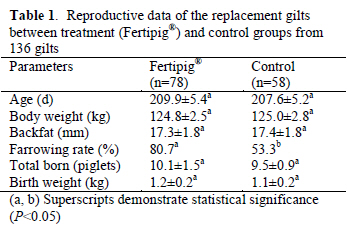



Gonadotropin Improves Oestrus in Late-puberty Replacement Gilts in Thailand
THAILAND - Gonadotropin (Fertipig, CEVA Animal Health) stimulated oestrus in late-puberty gilts in Thailand, according to researchers based in Mahasarakham and Bangkok.Introduction
Puberty in gilts is regarded when they expressed first standing oestrus and first ovulated1, according to A. Roongsitthichai from Mahasarakham University and co-authors from Chulalongkorn University, P. Tummaruk and N. Am-in. The replacement gilts should be in first oestrus before 200 days of age2.
Anoestrus can be delivered from several factors. One of the possible reasons is low or insufficient endogenous gonadotropin3, contributing to late puberty in pigs. A number of studies have attempted to stimulate oestrus in replacement gilts. A previous study reported that an injection of gonadotropin helps decrease days to oestrus after weaning in first and second litters3.
Comprehensive studies on improving oestrus in late puberty gilts were meager. Consequently, the purpose of the current study was to examine the capability of gonadotropin in stimulating oestrus in late-puberty gilts raised in Thailand.
Materials and Methods
In total, 136 gilts which did not express first observed oestrus within 200 days of age and weight at least 120kg were included. They were accommodated in an open housing system in eastern Thailand.
Due to the administration of gonadotropin (Fertipig®, CEVA Animal Health, Thailand), they were classified into control (n=58) and treatment (n=78) groups. After the injection for two days, oestrus detection by back pressure test, together with boar contact was conducted.
Those expressed oestrus signs were recorded and examined the follicle characteristics by ultrasonography (Aloka SSD-500V, Tokyo, Japan) in order to investigate dominant follicles.
Nonetheless, those did not show oestrus signs within 14 days after treatment would be removed to the slaughterhouse so as to scrutinise ovaries and uteri.
Recovery rate of the replacement gilts and farrowing rate were compared between groups by chi-square and total born piglets, and piglets’ birth weight were compared between groups by Student’s t-test (SAS 9.3, SAS Institute, Cary NC).
Results
Reproductive data of the gilts with late puberty are displayed in Table 1. The late-puberty gilts treated with Fertipig could express oestrus signs higher than those in control group significantly (92.31 versus 25.86 per cent; P<0.05; Figure 1).

In addition, the gilts in treatment group significantly possessed higher farrowing rate than those in control group (80.7 versus 53.3 per cent; P<0.05; Table 1).

Conclusions and Discussion
Gonadotropin was able to stimulate oestrus in the gilts with delayed puberty. An abnormality at Hypothalamic-pituitary axis, producing low GnRH, was one of the problems causing late puberty in pigs4.
According to Fertipig was composed of 400IU eCG and 200IU hCG, it could stimulate oestrus in late-puberty gilts in Thailand.
Acknowledgments: The present study was supported by CEVA Animal Health, Thailand.
References
- Evans and O'Doherty. 2001. Livest Prod Sci 106: 1-12.
- Tummaruk et al. 2009. Anim Reprod Sci 10: 10-122.
- Bates et al. 1991. J Anim Sci 96: 894-898.
- Estienne and Hartsock 1998. Theriogenology 49:823-828.







